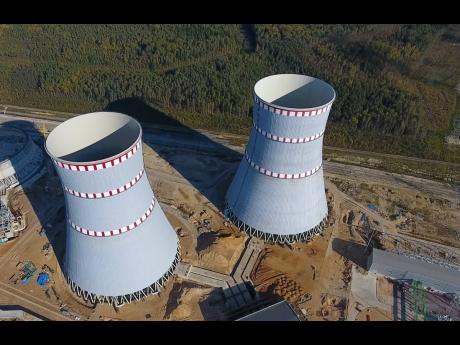Dennis Minott | The folly of small modular reactors
A costly and inefficient alternative to renewable energy
As the global community seeks effective solutions to combat climate change, the energy sector faces critical decisions regarding the most viable and sustainable sources of electricity. In recent years, Small Modular Reactors (SMRs) have been proposed for Jamaica as a potential alternative to traditional fossil fuel or nuclear power plants and a supplement to renewable energy sources. However, a thorough examination reveals that the cost, efficiency, and construction time of SMRs render them an impractical choice compared to renewable energy sources like wind and solar power. This essay explores the economic and operational shortcomings of SMRs, highlighting the folly of prioritising them over more cost-effective and sustainable alternatives.
The cost of electricity generated by SMRs is a significant deterrent. According to the CSIRO GenCost Australia report, the levelised cost of electricity (LCOE) for SMRs in 2023 is estimated to be between $380 and $640 per megawatt hour. This is starkly higher than the cost for wind and solar power, which ranges from $90 to $134 per megawatt hour in 2023, with projections to drop further to $70 to $100 by 2030. Even by 2030, when SMR costs are expected to fall to between $210 and $350 per megawatt hour, they will still be significantly more expensive than renewables. The Institute for Energy Economics and Financial Analysis (IEEFA) corroborates these findings, with its May 28 analysis indicating that SMRs remain economically uncompetitive when compared to wind and solar, whose costs are expected to range from $24 to $96 per megawatt hour by 2030.
SUBSTANTIAL CHALLENGES
The construction time of SMRs also presents substantial challenges. While proponents argue that SMRs can be built faster than traditional nuclear reactors, they still require a significant amount of time compared to renewable energy installations. SMRs even in totalitarian states like Russia and China typically took between 12 and 15 years to construct, depending on the specific design and location. However, historical examples paint a more troubling picture. For instance, two SMRs in Russia’s Far East each took over 12 years to complete and were over budget by more than 300 per cent. Similarly, a small SMR in East China took 12 years to construct, far exceeding initial projections of three years. This protracted construction time contrasts sharply with the rapid deployment of renewable energy projects. Wind turbines can be installed within a few months to a year, and solar panels often take just weeks to a few months to set up, making them far more efficient and timely solutions for addressing immediate energy needs.
Beyond cost and construction time, SMRs face several operational inefficiencies. SMRs have lower thermal efficiency compared to conventional fossil fuel plants or nuclear reactors, leading to higher operating costs. This inefficiency makes them less competitive with other energy sources. Furthermore, SMRs generate a significant amount of radioactive waste. They produce 30 times more long-lived and 35 times more low – to intermediate-level radioactive waste than conventional reactors, posing severe environmental and health risks. This waste-management issue adds to the operational costs and challenges of SMRs, diminishing their appeal as a sustainable energy solution.
The commercial viability of SMRs is another area of concern. Despite extensive promotion by money-men, only three SMRs have been made operational worldwide to date, with many projects being cancelled due to technical and economic hurdles. For instance, a proposed SMR plant near Buenos Aires, which began construction over 13 years ago, remains incomplete and significantly over budget. This lack of commercial success further underscores the challenges and uncertainties surrounding SMR technology.
In contrast, renewable energy sources like wind, biomass, and solar have consistently demonstrated their economic and operational advantages. The costs associated with wind and solar power have been declining steadily, driven by technological advancements and economies of scale. Wind, biomass, and solar installations also benefit from shorter construction times and lower operational risks, making them more attractive options for rapidly expanding clean energy capacity. Additionally, renewable energy sources do not produce hazardous waste, thus mitigating environmental and health concerns.
MORE EFFECTIVE
The IEEFA argues that investing in renewable energy sources is more effective for reducing emissions and meeting climate targets. The high costs, inefficiencies, long construction times, and environmental concerns associated with unproven concept SMRs make them less competitive and less effective in addressing the climate crisis. As the world transitions to a more sustainable energy future, it is crucial to prioritise technologies that offer the greatest benefits in terms of cost, efficiency, and environmental impact.
Here’s the thing. While SMRs may present a fervidly imagined alternative to traditional power sources and a supplement to renewable energy sources, their practical implementation reveals significant drawbacks. The high costs of electricity generation, lengthy construction times, operational inefficiencies, and environmental risks associated with SMRs make them an impractical choice compared to wind, biomass, and solar power. As we strive to combat climate change and transition to sustainable energy systems, it is essential to focus on proven, cost-effective, and efficient technologies. The folly of prioritising SMRs over renewable energy sources could result in wasted resources and missed opportunities for achieving a cleaner, more sustainable future.
The Commonwealth Scientific and Industrial Research Organisation (CSIRO) is an Australian Government agency responsible for scientific research. {I became acutely aware of CSIRO’s role in world science and industrial development while I completed a rigorous PhD in instrumentation and controls based on a power engineering background. I am very certain that our own Scientific Research Council (SRC) gained its own initial inspiration from the CSIRO.
CSIRO works with leading organisations around the world. From its headquarters in Canberra, CSIRO maintains more than 50 sites across Australia and in France, Chile, and the United States, employing about 5,500 people.
Dennis Minott, PhD, is the CEO of A-QuEST-FAIR. He is a multilingual green resources specialist, a research physicist, and a modest mathematician who worked in the oil and energy sector. Send feedback to: a_quest57@yahoo.com or columns@gleanerjm.com.


